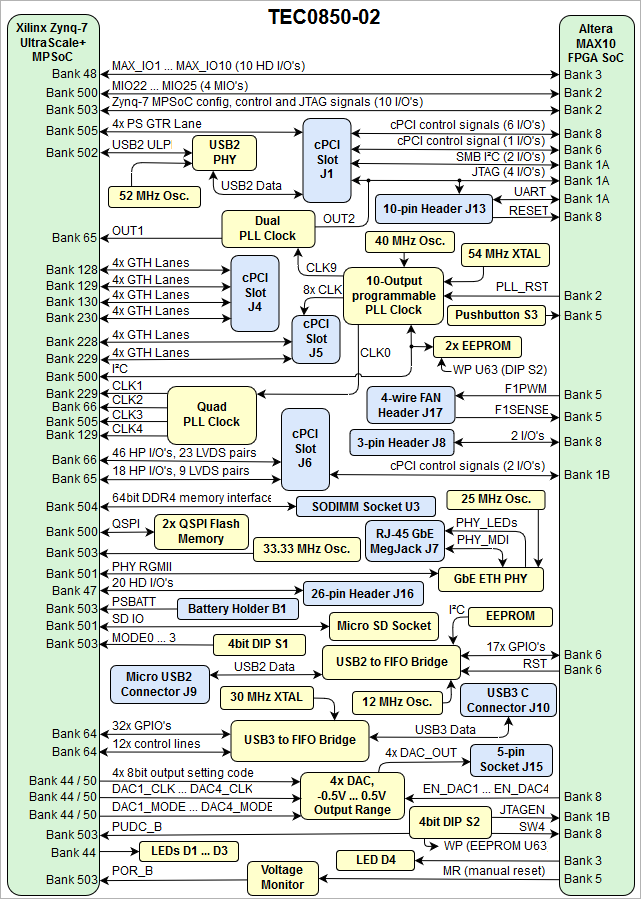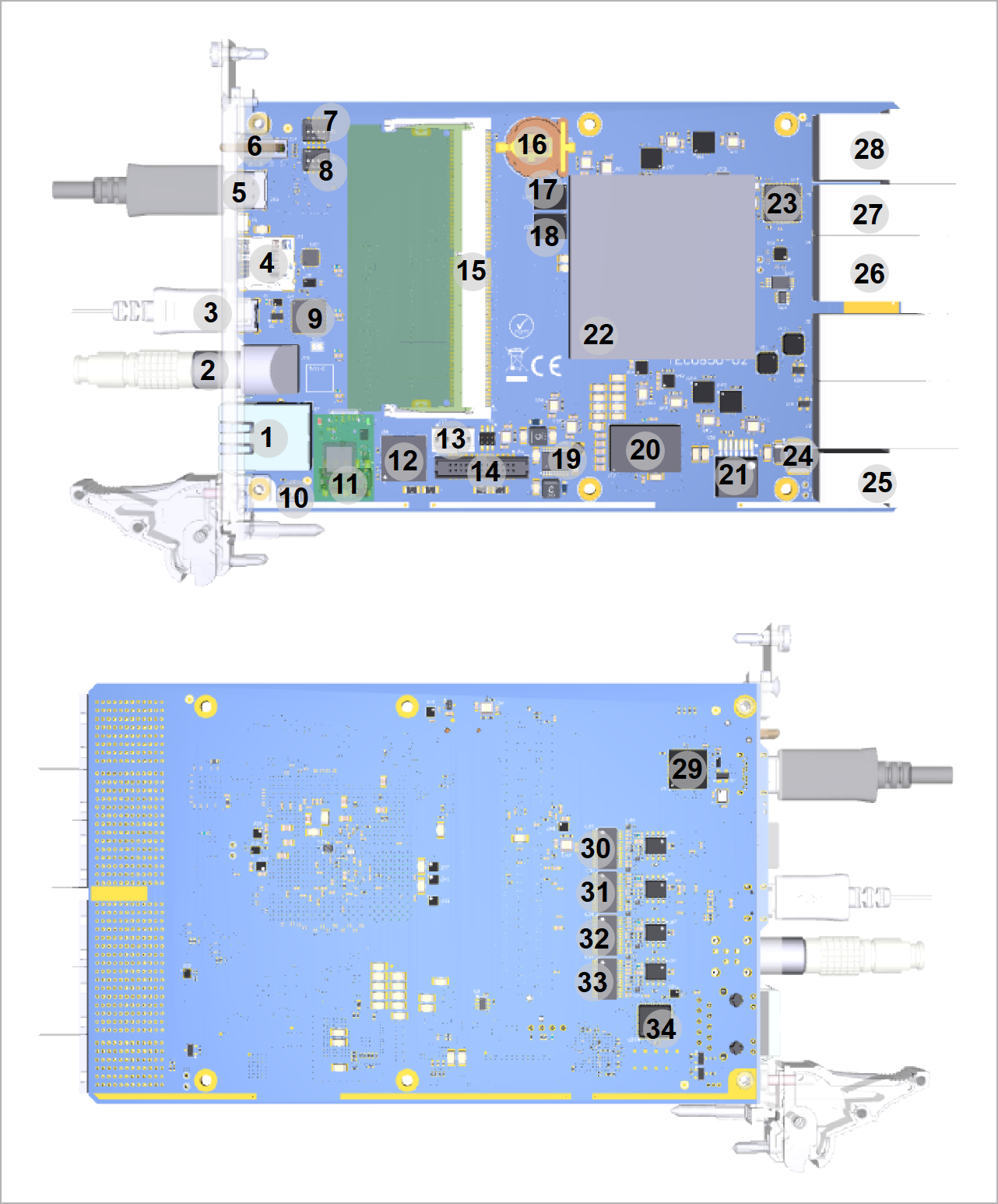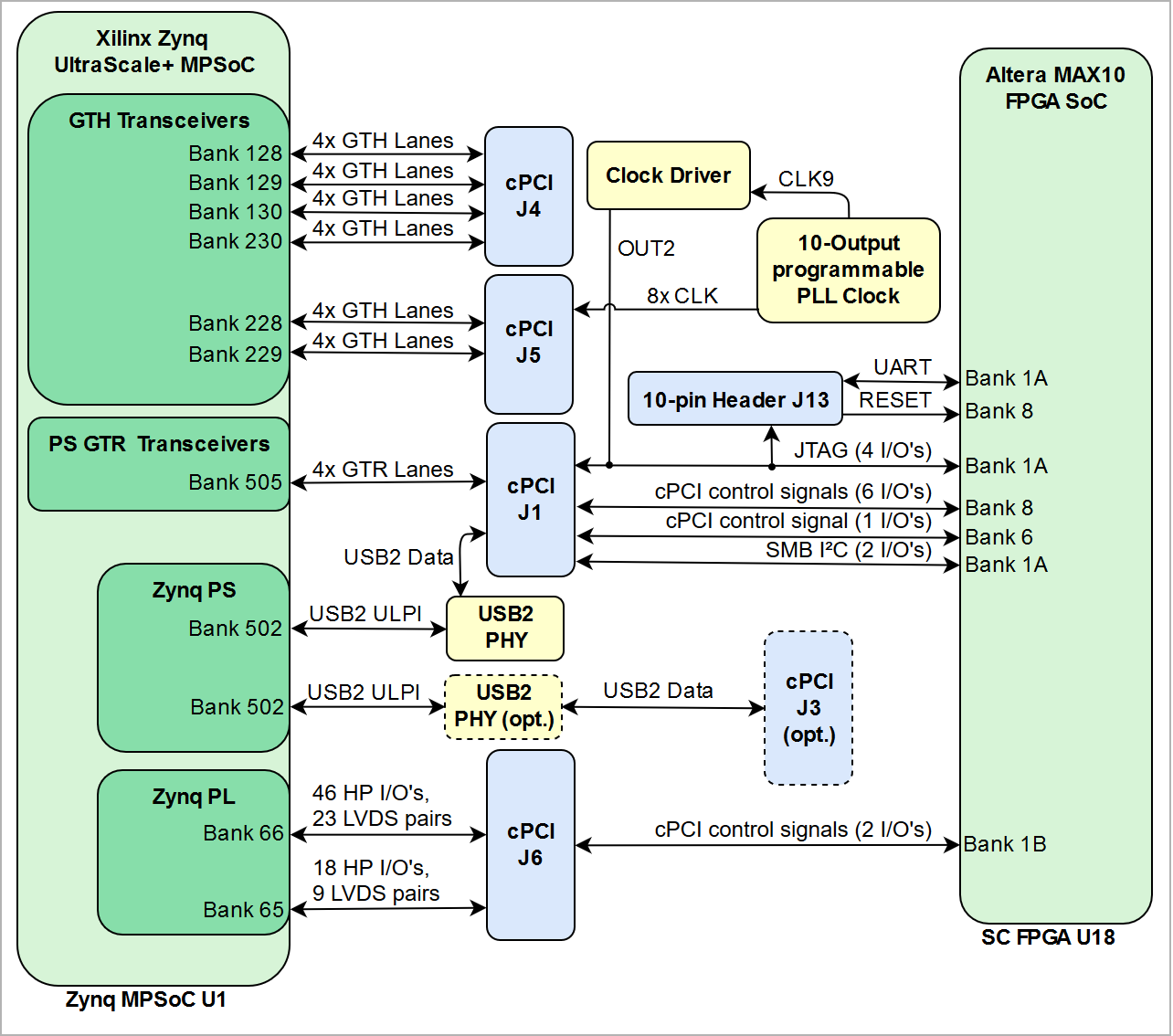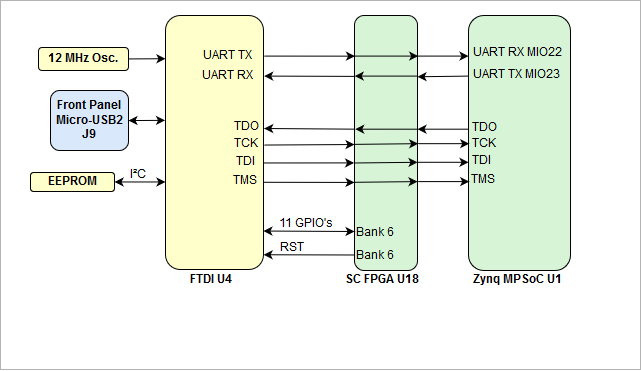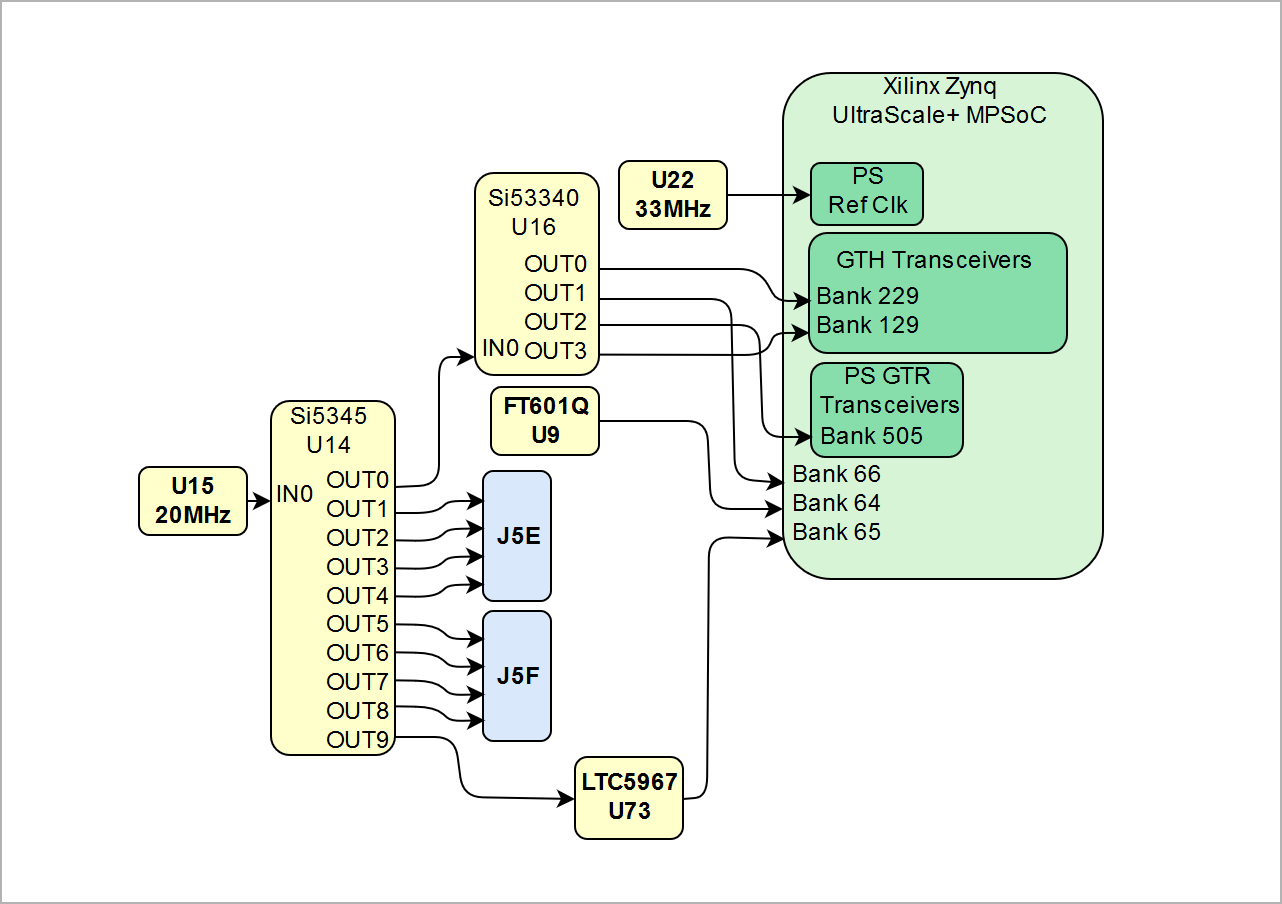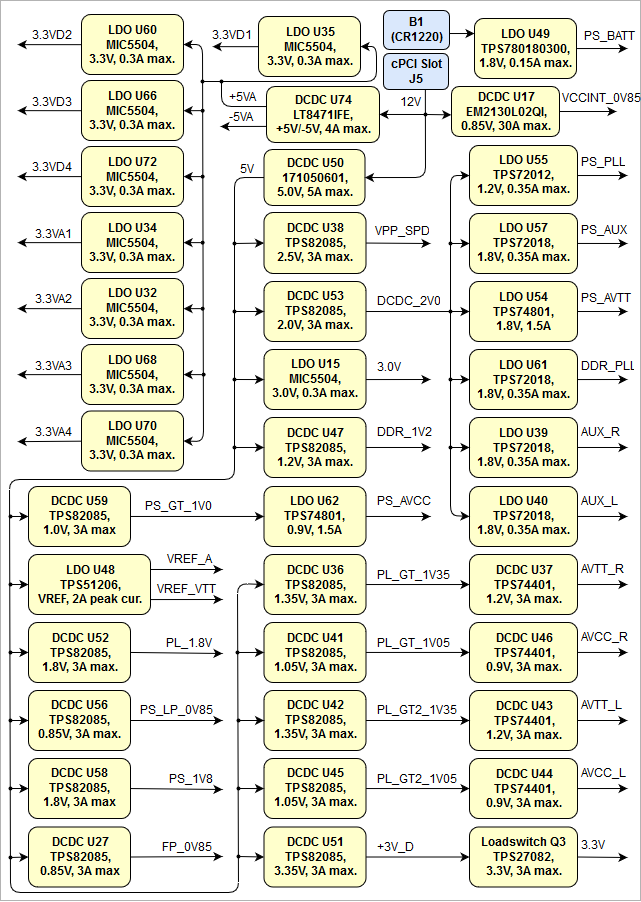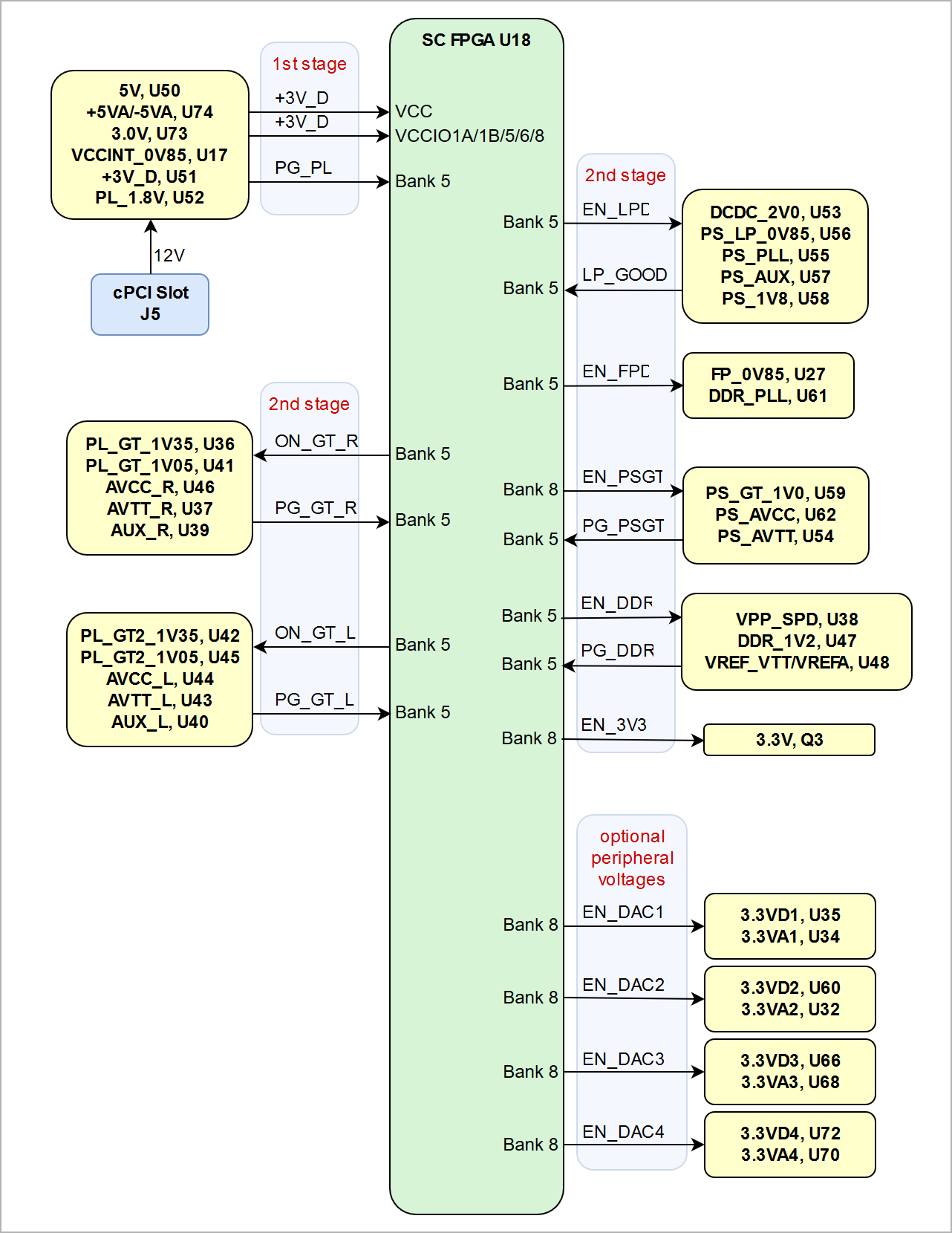Template Revision 2.0 - on construction TRM Name always "TE Series Name" +TRM, for example "TE0720 TRM" |
<style>
.wrapped{
width: 100% !important;
max-width: 1200px !important;
}
</style> |
----------------------------------------------------------------------- |
Note for Download Link of the Scroll ignore macro: |
Table of Contents 
|
Overview
The Trenz Electronic TEC0850 board is a CompactPCI card (3U form factor) integrating a Xilinx Zynq UltraScale+ MPSoC, one DDR4 SDRAM SODIMM socket with 64bit wide databus, max. dual 512 MByte Flash memory for configuration and operation, 24 Gigabit transceivers on PL side and 4 on PS side, powerful switch-mode power supplies for all on-board voltages, USB2 and USB3 FIFO bridges and a large number of configurable I/Os available on the CompactPCI backplane connectors.
Refer to http://trenz.org/tec0850-info for the current online version of this manual and other available documentation.
|
Key Features
Notes: - List of key features of the PCB
|
Zynq UltraScale+ MPSoC ZU15
- Front side interface connectors
- RJ-45 GbE Ethernet interface
- Elbow Socket with 4x on-board 8bit DAC output
- MicroSD Card connector
- USB2 and USB3 to FIFO bridge connector
- 4x status LEDs
- 4 CompactPCI connectors for backplane connection (3U form factor)
- 24 GTH lanes
- 4 PS GTR lanes
- USB2 interface
- 64 Zynq PL HP I/O's
- 8x PLL clock input
- JTAG, I²C and 7 user I/O's to MAX10 FPGA
64bit DDR4 SODIMM (PS connected), 8 GByte maximum
Dual parallel QSPI Flash (bootable), 512 MByte maximum
- 26-pin header with 20 Zynq PL HD I/O's
- 3-pin header with 2 MAX10 FPGA I/O's
- System Controller (Altera MAX10 FPGA SoC)
- Power Sequencing
- System management and control for MPSoC and on-board peripherals
- Si5345 programmable 10 output PLL clock generator
- Si53340 Quad PLL clock generator
- 2x 4bit DIP switches
- 1x user push button
- Zynq MPSoC cooling FAN connector
- On-board high-efficiency DC-DC converters
Block Diagram
Main Components
Notes : - Picture of the PCB (top and bottom side) with labels of important components
- Add List below
|
- GbE RJ-45 MagJack, J7
- DAC output 5-pin elbow receptacle socket, J15
- Micro USB2 B receptacle connector, J9
- MicroSD Card socket, J11
- USB C connector, J10
- LED light pipes J14 integrating LEDs D1 ... D4
- 4bit DIP-switch, S2
- 4bit DIP-switch, S1
- FTDI FT2232 USB2 to FIFO bridge, U4
- 3-pin header, J8
- MAX10 FPGA JTAG/UART 10-pin header, J13
- Altera MAX10 System Controller FPGA, U18
- 4-Wire PWM fan connector, J17
- Zynq MPSoC PL I/O 26-pin header, J16
- DDR4 SO-DIMM 260-pin socket, U3
- Battery Holder CR1220, B1
- 256 Mbit (32 MByte) Micron Serial NOR Flash Memory N25Q256A, U24
- 256 Mbit (32 MByte) Micron Serial NOR Flash Memory N25Q256A, U25
- DC-DC Converter LT8471IFE @+5VA/-5VA, U74
- DC-DC Converter EM2130L02QI @VCCINT_0V85, U17
- DC-DC Converter 171050601 @5V, U50
- Xilinx Zynq Ultrascale+ MPSoC, U1
- Si5345A 10-output I²C programmable PLL clock, U14
- Main power fuse @2.5A/16V, F1
- cPCI connector, J1
- cPCI connector, J4
- cPCI connector, J5
- cPCI connector, J6
- FTDI FT601Q USB3 to FIFO bridge, U9
- TI THS5641 8bit DAC ,U28
- TI THS5641 8bit DAC ,U31
- TI THS5641 8bit DAC ,U29
- TI THS5641 8bit DAC ,U33
- Marvell Alaska 88E1512 GbE PHY ,U20
Initial Delivery State

Storage device name | Content | Notes |
|---|
| User configuration EEPROMs (1x Microchip 24AA128T-I/ST, 1x Microchip 24AA025E48T-I/OT) | Empty | Not programmed | | USB2 to FIFO bridge configuration EEPROM (ST M93C66) | Empty | Not programmed | | Si5345A programmable PLL NVM OTP | Empty | Not programmed | | 2x QSPI Flash memory | Empty | Not programmed |
|
Control Signals
- Overview of Boot Mode, Reset, Enables,
|
Signals, Interfaces and Pins
Notes : - For carrier or stand-alone boards use subsection for every connector typ (add designator on description, not on the subsection title), for example:
- For modules which needs carrier us only classes and refer to B2B connector if more than one is used, for example
|
CompactPCI Backplane Connectors
The TEC0850 board is equipped with 3 CompactPCI high speed backplane connectors which provides serial high-speed interconnects with transmission rates up to 12 Gb/s to the Zynq MPSoCs MGT lanes, high speed USB2 interface and single ended FPGA I/O pins Zynq MPSoC and the System Controller FPGA.
The connectors support single ended and differential signaling as the Zynq MPSoC FPGA I/O's are routed from the FPGA banks as LVDS-pairs to the backplane connector.
The TEC0850 board is designed to be connected to the System Slot of the backplane connector, whereby 4 of the 6 connectors of the System Slot configuration are fitted to the TEC0850 board.
Following diagram gives an overview of the CompactPCI backplane connectors and their connections to the Zynq Ultrascale+ MPSoC and the System Controller FPGA U18:
Following tables contains information about the interfaces, I/O's, clock and VCCIO sources available on the cPCI connectors:
- CompactPCI Connector J1
- CompactPCI Connector J4
- CompactPCI Connector J5
- CompactPCI Connector J6

CompactPCI Connector J1

cPCI connector J1 Interfaces: | cPCI Connector | Interfaces | I/O Signal Count | LVDS-pairs count | Connected to | VCCO bank Voltage | Notes |
|---|
J1 | I/O | 1 | - | SC FPGA U18 Bank 6 | +3V_D | control signals in cPCI pin assingment | | 6 | - | SC FPGA U18 Bank 8 | +3V_D | control signals in cPCI pin assingment | | I²C | 2 | - | SC FPGA U18 Bank 1A | +3V_D | SC FPGA U18 I²C interface | | JTAG | 4 | - | SC FPGA U18 Bank 1A | +3V_D | SC FPGA U18 JTAG interface | | MGT | - | 8 (4 x RX/TX) | Bank 502 PS GTR | - | 4x PS GTR lanes | | USB2 | - | 1 (RX/TX) | USB2 PHY U11 | - | USB2 OTG A-Device (host) | | Clock Input | - | 1 | Clock Driver U73 | - | 1x Reference clock input from PLL clock U14 |
|

cPCI connector J1 MGT Lanes:
| cPCI Connector | MGT Lane | Bank | Type | Signal Schematic Name | cPCI Connector Pin | FPGA Pin |
|---|
| J1 | 0 | 505 | GTR | - PE1_RX0_P
- PE1_RX0_N
- PE1_TX0_P
- PE1_TX0_N
| J1-D5
J1-E5
J1-A5
J1-B5 | PS_MGTRRXP0_505, AB29
PS_MGTRRXN0_505, AB30
PS_MGTRTXP0_505, AB33
PS_MGTRTXN0_505, AB34 | | 1 | 505 | GTR | - PE1_RX1_P
- PE1_RX1_N
- PE1_TX1_P
- PE1_TX1_N
| J1-J5
J1-K5
J1-G5
J1-H5 | PS_MGTRRXP1_505, Y29
PS_MGTRRXN1_505, Y30
PS_MGTRTXP1_505, AA31
PS_MGTRTXN1_505, AA32 | | 2 | 505 | GTR | - PE1_RX2_P
- PE1_RX2_N
- PE1_TX2_P
- PE1_TX2_N
| J1-E6
J1-F6
J1-B6
J1-C6 | PS_MGTRRXP2_505, W31
PS_MGTRRXN2_505, W32
PS_MGTRTXP2_505, Y33
PS_MGTRTXN2_505, Y34 | | 3 | 505 | GTR | - PE1_RX3_P
- PE1_RX3_N
- PE1_TX3_P
- PE1_TX3_N
| J1-K6
J1-L6
J1-H6
J1-I6 | PS_MGTRRXP3_505, V29
PS_MGTRRXN3_505, V30
PS_MGTRTXP3_505, V33
PS_MGTRTXN3_505, V34 |
|

cPCI connector J1 clock signal from PLL U14 is also shared with SC FPGA and header J13 : | Clock Signal Schematic Name | cPCI Connector Pin | Header J13 Pin | SC FPGA U18 Pin | Notes |
|---|
| J1-K3
J1-J3 | J13-5
J13-1 | Bank 1B, Pin G1
Bank 1B, Pin G2 | Supplied by 10-output PLL clock U14 |
|

cPCI connector J1 VCC/VCCIO: | cPCI Connector | Available VCC/VCCIO | cPCI Connector Pin | Source | Notes |
|---|
J1 | VIN_12V | J1-A1
J1-D1
J1-E1
J1-G1
J1-H1
J1-J1
J1-K1 | cPCI backplane
| min. cur.: 6.65A |
|

CompactPCI Connector J4

| cPCI Connector | Interfaces | I/O Signal Count | LVDS-pairs count | Connected to | VCCO bank Voltage | Notes |
|---|
| J4 | MGT | - | 32 (16 x RX/TX) | Bank 128 GTH
Bank 129 GTH
Bank 130 GTH
Bank 230 GTH | - | - |
|

| MGT Lane | Bank | Type | Signal Schematic Name | cPCI Connector Pin | FPGA Pin |
|---|
| 0 | 128 | GTH | - PE3_RX0_P
- PE3_RX0_N
- PE3_TX0_P
- PE3_TX0_N
| J4-D1
J4-E1
J4-A1
J4-B1 | MGTHRXP0_128, T33
MGTHRXN0_128, T34
MGTHTXP0_128, T29
MGTHTXN0_128, T30 | | 1 | 128 | GTH | - PE3_RX1_P
- PE3_RX1_N
- PE3_TX1_P
- PE3_TX1_N
| J4-J1
J4-K1
J4-G1
J4-H1 | MGTHRXP1_128, P33
MGTHRXN1_128, P34
MGTHTXP1_128, R31
MGTHTXN1_128, R32 | | 2 | 128 | GTH | - PE3_RX2_P
- PE3_RX2_N
- PE3_TX2_P
- PE3_TX2_N
| J4-E2
J4-F2
J4-B2
J4-C2 | MGTHRXP2_128, N31
MGTHRXN2_128, N32
MGTHTXP2_128, P29
MGTHTXN2_128, P30 | | 3 | 128 | GTH | - PE3_RX3_P
- PE3_RX3_N
- PE3_TX3_P
- PE3_TX3_N
| J4-K2
J4-L2
J4-H2
J4-I2 | MGTHRXP3_128, M33
MGTHRXN3_128, M34
MGTHTXP3_128, M29
MGTHTXN3_128, M30 | | 0 | 129 | GTH | - PE4_RX0_P
- PE4_RX0_N
- PE4_TX0_P
- PE4_TX0_N
| J4-D3
J4-E3
J4-A3
J4-B3 | MGTHRXP0_129, L31
MGTHRXN0_129, L32
MGTHTXP0_129, K29
MGTHTXN0_129, K30 | | 1 | 129 | GTH | - PE4_RX1_P
- PE4_RX1_N
- PE4_TX1_P
- PE4_TX1_N
| J4-J3
J4-K3
J4-G3
J4-H3 | MGTHRXP1_129, K33
MGTHRXN1_129, K34
MGTHTXP1_129, J31
MGTHTXN1_129, J32 | | 2 | 129 | GTH | - PE4_RX2_P
- PE4_RX2_N
- PE4_TX2_P
- PE4_TX2_N
| J4-E4
J4-F4
J4-B4
J4-C4 | MGTHRXP2_129, H33
MGTHRXN2_129, H34
MGTHTXP2_129, H29
MGTHTXN2_129, H30 | | 3 | 129 | GTH | - PE4_RX3_P
- PE4_RX3_N
- PE4_TX3_P
- PE4_TX3_N
| J4-K4
J4-L4
J4-H4
J4-I4 | MGTHRXP3_129, F33
MGTHRXN3_129, F34
MGTHTXP3_129, G31
MGTHTXN3_129, G32 | | 0 | 130 | GTH | - PE5_RX0_P
- PE5_RX0_N
- PE5_TX0_P
- PE5_TX0_N
| J4-D5
J4-E5
J4-A5
J4-B5 | MGTHRXP3_130, B33
MGTHRXN3_130, B34
MGTHTXP3_130, A31
MGTHTXN3_130, A32 | | 1 | 130 | GTH | - PE5_RX1_P
- PE5_RX1_N
- PE5_TX1_P
- PE5_TX1_N
| J4-J5
J4-K5
J4-G5
J4-H5 | MGTHRXP2_130, C31
MGTHRXN2_130, C32
MGTHTXP2_130, B29
MGTHTXN2_130, B30 | | 2 | 130 | GTH | - PE5_RX2_P
- PE5_RX2_N
- PE5_TX2_P
- PE5_TX2_N
| J4-E6
J4-F6
J4-B6
J4-C6 | MGTHRXP1_130, D33
MGTHRXN1_130, D34
MGTHTXP1_130, D29
MGTHTXN1_130, D30 | | 3 | 130 | GTH | - PE5_RX3_P
- PE5_RX3_N
- PE5_TX3_P
- PE5_TX3_N
| J4-K6
J4-L6
J4-H6
J4-I6 | MGTHRXP0_130, E31
MGTHRXN0_130, E32
MGTHTXP0_130, F29
MGTHTXN0_130, F30 | | 0 | 230 | GTH | - PE6_RX0_P
- PE6_RX0_N
- PE6_TX0_P
- PE6_TX0_N
| J4-D7
J4-E7
J4-A7
J4-B7 | MGTHRXP3_230, A4
MGTHRXN3_230, A3
MGTHTXP3_230, A8
MGTHTXN3_230, A7 | | 1 | 230 | GTH | - PE6_RX1_P
- PE6_RX1_N
- PE6_TX1_P
- PE6_TX1_N
| J4-J7
J4-K7
J4-G7
J4-H7 | MGTHRXP2_230, B2
MGTHRXN2_230, B1
MGTHTXP2_230, B6
MGTHTXN2_230, B5 | | 2 | 230 | GTH | - PE6_RX2_P
- PE6_RX2_N
- PE6_TX2_P
- PE6_TX2_N
| J4-E8
J4-F8
J4-B8
J4-C8 | MGTHRXP1_230, C4
MGTHRXN1_230, C3
MGTHTXP1_230, D6
MGTHTXN1_230, D5 | | 3 | 230 | GTH | - PE6_RX3_P
- PE6_RX3_N
- PE6_TX3_P
- PE6_TX3_N
| J4-K8
J4-L8
J4-H8
J4-I8 | MGTHRXP0_230, D2
MGTHRXN0_230, D1
MGTHTXP0_230, E4
MGTHTXN0_230, E3 |
|

CompactPCI Connector J5

| cPCI Connector | Interfaces | I/O Signal Count | LVDS-pairs count | Connected to | VCCO bank Voltage | Notes |
|---|
| J5 | MGT | - | 16 (8 x RX/TX) | Bank 128 GTH
Bank 128 GTH | - | - | | Clock Input | - | 8 | PLL clock U14 | - | - |
|

cPCI connector J5 MGT Lanes: | cPCI Connector | MGT Lane | Bank | Type | Signal Schematic Name | cPCI Connector Pin | FPGA Pin |
|---|
| J5 | 0 | 228 | GTH | - PE8_RX0_P
- PE8_RX0_N
- PE8_TX0_P
- PE8_TX0_N
| J5-D3
J5-E3
J5-A3
J5-B3 | MGTHRXP0_228, T2
MGTHRXN0_228, T1
MGTHTXP0_228, R4
MGTHTXN0_228, R3 | | 1 | 228 | GTH | - PE8_RX1_P
- PE8_RX1_N
- PE8_TX1_P
- PE8_TX1_N
| J5-J3
J5-K3
J5-G3
J5-H3 | MGTHRXP1_228, P2
MGTHRXN1_228, P1
MGTHTXP1_228, P6
MGTHTXN1_228, P5 | | 2 | 228 | GTH | - PE8_RX2_P
- PE8_RX2_N
- PE8_TX2_P
- PE8_TX2_N
| J5-E4
J5-F4
J5-B4
J5-C4 | MGTHRXP2_228, M2
MGTHRXN2_228, M1
MGTHTXP2_228, N4
MGTHTXN2_228, N3 | | 3 | 228 | GTH | - PE8_RX3_P
- PE8_RX3_N
- PE8_TX3_P
- PE8_TX3_N
| J5-K4
J5-L4
J5-H4
J5-I4 | MGTHRXP3_228, L4
MGTHRXN3_228, L3
MGTHTXP3_228, M6
MGTHTXN3_228, M5 | | 0 | 229 | GTH | - PE7_RX0_P
- PE7_RX0_N
- PE7_TX0_P
- PE7_TX0_N
| J5-D1
J5-E1
J5-A1
J5-B1 | MGTHRXP0_229, K2
MGTHRXN0_229, K1
MGTHTXP0_229, K6
MGTHTXN0_229, K5 | | 1 | 229 | GTH | - PE7_RX1_P
- PE7_RX1_N
- PE7_TX1_P
- PE7_TX1_N
| J5-J1
J5-K1
J5-G1
J5-H1 | MGTHRXP1_229, J4
MGTHRXN1_229, J3
MGTHTXP1_229, H6
MGTHTXN1_229, H5 | | 2 | 229 | GTH | - PE7_RX2_P
- PE7_RX2_N
- PE7_TX2_P
- PE7_TX2_N
| J5-E2
J5-F2
J5-B2
J5-C2 | MGTHRXP2_229, H2
MGTHRXN2_229, H1
MGTHTXP2_229, G4
MGTHTXN2_229, G3 | | 3 | 229 | GTH | - PE7_RX3_P
- PE7_RX3_N
- PE7_TX3_P
- PE7_TX3_N
| J5-K2
J5-L2
J5-H2
J5-I2 | MGTHRXP3_229, F2
MGTHRXN3_229, F1
MGTHTXP3_229, F6
MGTHTXN3_229, F5 |
|

cPCI connector J5 Clock Signals: | cPCI Connector | PLL Clock Output | Signal Schematic Name | cPCI Connector Pin | Notes |
|---|
| J5 | OUT1 | | J5-A5
J5-B5 | Supplied by on-board
10-output PLL clock generator U14 | | OUT2 | | J5-D5
J5-E5 | | OUT3 | | J5-G5
J5-H5 | | OUT4 | | J5-J5
J5-K5 | | OUT5 | | J5-B6
J5-C6 | | OUT6 | | J5-E6
J5-F6 | | OUT7 | | J5-H6
J5-I6 | | OUT8 | | J5-K6
J5-L6 |
|

CompactPCI Connector J6

cPCI connector J1 Interfaces: | cPCI Connector | Interfaces | I/O Signal Count | LVDS-pairs count | Connected to | VCCO bank Voltage | Notes |
|---|
J1 | I/O | 46 | 23 | PL bank 66 | PL_1.8V | - | | 18 | 9 | PL bank 65 | PL_1.8V | - | | 2 | - | SC FPGA U18 Bank 1B | +3V_D | Signalname: 'DET_RIO', 'DET_BPR' |
|
USB-C Connector
Front panel USB-C Interface is connected to USB FIFO bridge chip FT601Q. 32-bit FIFO bridge provides a simple high-speed interface to Zynq UltraScale+ PL.

The USB3 to FIFO bridge U9 is connected to the Zynq MPSoC's PL bank 64 and is accessible through USB-C connector J10: | IC | Interface | Signal Schematic Names | Connected to | Notes |
|---|
FT601Q U9
| USB3 data lane | - SSRX_P
- SSRX_N
- SSTXX_P
- SSTXX_N
| USB C Connector J10 | - | | USB2 data lane | | USB C Connector J10 | - | | Control Lines | - FTDI_RESET_N
- WAKEUP_N
- SIWU_N
- TXE_N
- RXF_N
- WR_N
- RD_N
- OE_N
- BE_0
- BE_1
- BE_2
- BE_3
- FIFO_CLK
| PL bank 64
| - | | Parallel GPIO's | | PL bank 64 | - |
|
See FT600Q-FT601Q IC Datasheet for interface details.
Micro-USB2 Connector
Front panel Micro-USB2 Interface provides access to UART and JTAG functions via FTDI FT2232 chip. Use of this feature requires that USB driver is installed on your host PC. UART0 with MIO 22 .. 23 should be selected in "Zynq UltraScale+ MPSoC" configuration.
The Digilent plug-in software and cable drivers must be installed on your machine for you to be able to use JTAG interface.

The USB2 to FIFO bridge U4 is connected to the SC FPGA U18 and is accessible through Micro-USB2 connector J9: | IC | Interface | Signal Schematic Names | Connected to | Notes |
|---|
| FT2232H U4 | USB2 data lane | | Micro-USB2 connector J9 | - | | Control Lines | | SC FPGA U18, bank 6
| - | | Parallel GPIO's | - ADBUS0
- ADBUS1
- ADBUS2
- ADBUS3
- BDBUS0
- BDBUS1
- BDBUS2
- BDBUS3
- BDBUS4
- BDBUS5
- BDBUS6
- BDBUS7
- BCBUS0
- BCBUS1
- BCBUS2
- BCBUS3
- BCBUS4
| SC FPGA U18, bank 6 | - |
|
SD
The SD Card interface of the TEC0850 board is not directly wired to the connector J11 pins, but through a Texas Instruments TXS02612 SD IO Port Expander, which is needed for voltage translation due to different voltage levels of the Micro SD Card and MIO-bank of the Xilinx Zynq MPSoC. The Micro SD Card has 3.3V signal voltage level, but the PS MIO-bank on the Xilinx Zynq MPSoC has VCCIO of 1.8V.
There are some limitations to use SD card Interface in Linux.
- Zynq UltraScale+ SD controller is working only in the 3.3V mode as it connected to SD card socket using 1.8V to 3.3V level shifter U10.
- Micro SD card socket has no "Write Protect" switch.
To force Linux driver not to use this features add following instructions to device tree file. &sdhci1 { no-1-8-v;
disable-wp;
}; |
RJ45 - Ethernet
On-board Gigabit Ethernet PHY is provided with Marvell Alaska 88E1512 IC U20. The Ethernet PHY RGMII interface is connected to the Zynq MPSoC Ethernet interface of the PS MIO bank 501. I/O voltage is fixed at 1.8V for HSTL signaling. The reference clock input of the PHY is supplied from the on-board 25.000000 MHz oscillator U21. The LEDs of the RJ-45 MegJack J13 are connected to the GbE PHY U20 status LED output.
DDR4 SODIMM Socket
On the TEC0850 board there is a DDR4 memory interface U3 with a 64-bit databus width available for SO-DIMM modules connected to the Zynq UltraScale+ DDRC hard memory controller.

Following table gives an overview about the I/O signals of the DDR4 SDRAM memory interface:
| Connector | DDR4 SDRAM I/O Signal | Signal Schematic Name | Connected to | Notes |
|---|
DDR4 SO-DIMM Socket U3 | Address inputs | | PS DDR Bank 504 | - | Bank address inputs
| | - | | Bank group inputs | | - | | Differential clocks | - DDR4-CLK0_P
- DDR4-CLK0_N
- DDR4-CLK1_P
- DDR4-CLK1_N
| 2 x DDR4 clock | | Data input/output | | - | | Check bit input/output | | - | | Data strobe (differential) | - DDR4-DQS0_P
- DDR4-DQS0_N
- ...
- DDR4-DQS8_P
- DDR4-DQS8_N
| - | | Data mask and data bus inversion | | - | | Serial address inputs | | address range configuration on I²C bus | | Control Signals | | chip selest signal | | On-die termination enable | | nRESET | | Command and address parity input | | Clock enable | | CRC error flag | | Activation command input | | Temperature event | | I²C | | not connected | - |
|
Circular Push Pull Connector
26-pin Header 2,54mm (2x13)
10-Pin Header 2,54mm (2x5)
3-Pin PicoBlade Connector
Battery holder
4-Wire PWM FAN Connectors
On-board Peripherals
Notes : - add subsection for every component which is important for design, for example:
- Ethernet PHY
- USB PHY
- Programmable Clock Generator
- Oscillators
- eMMCs
- RTC
- FTDI
- ...
- DIP-Switches
- Buttons
- LEDs
|
Subsections...
Zynq UltraScale XCZU15EG MPSoC
The TEC0850 board is populated with the Zynq UltraScale+ XCZU15EG-1FFVB1156E MPSoC.
Main IO interfaces are shown on the image below.
PS MIO Configuration

| MIO | Interface |
|---|
| MIO 0...12 | QSPI Flash Memory | | MIO 20...21 | I2C 1 | | MIO 22...23 | UART 0 | | MIO 26...37 | GEM 0 | | MIO 46...51 | SD 1 | | MIO 52...63 | USB 0 | | MIO 64...75 | USB 1 | | MIO 76...77 | MDIO 0 |
|
MAX10 System Controller
System controller chip is Intel MAX10 10M08SAU169C8G Chip with board control firmware.
Programmable Clock Generators
I2C
The onboard I2C bus is connected to MIO 20...21 pins. Devices on the bus shown in the table below.

| I2C address | Chip | Description |
|---|
| 0x69 | U14 Si5345 | Clock generator and distributor |
|
Oscillators
FTDIs
FT2232H
FT601Q-B-T
Quad-SPI Flash Memory
Board has two N25Q512A11G1240E connected in a dual parallel mode.
EEPROMs
I2C
The onboard I2C bus is connected to MIO 20...21 pins. Devices on the bus shown in the table below.

| I2C address | Chip | Description |
|---|
| 0x50 | U63 24AA128T-I/ST | 128K Serial EEPROM | | 0x53 | U64 24AA025E48T-I/OT | 2K Serial EEPROM with EUI-48™ or EUI-64™ Node Identity |
|
USB PHY
Gigabit Ethernet PHY
Board has Marvell Alaska 88E1512 Ethernet PHY which use MDIO address 1.
8Bit DACs
Board has 4 8-bit parallel Texas Instruments THS5641 DACs with up to 100 MSPS Update Rate.
DIP-Switches
S1

| Switch | Description |
|---|
| 1 | Boot Mode 0 | | 2 | Boot Mode 1 | | 3 | Boot Mode 2 | | 4 | Boot Mode 3 |
|
See Zynq UltraScale+ Device Technical Reference Manual page 236 for full boot modes description. Most common modes are

| Boot Mode | SW1:4 | SW1:3 | SW1:2 | SW1:1 |
|---|
| JTAG Boot Mode | ON | ON | ON | ON | | Quad-SPI | ON | ON | ON | OFF | | SD Card | ON | ON | OFF | OFF |
|
S2

| Switch | Description |
|---|
| 1 | SC JTAGEN | | 2 | EEPROM WP (Write protect) | | 3 | FPGA PUDC | | 4 | SC Switch (Reserved for future use) |
|
Buttons
LEDs

| LED | Signal | Chip | Pin | Description |
|---|
| Front panel LED 1 (Red) | LED_FP_1 | FPGA U1 | AF15 | PL User defined LED | | Front panel LED 2 (Green) | LED_FP_2 | FPGA U1 | AG15 | PL User defined LED | | Front panel LED 3 (Green) | LED_FP_3 | FPGA U1 | AE15 | PL User defined LED | | Front panel LED 4 (Green) | LED_FP_4 | SC U18 | M4 | Power Good |
|
Power and Power-On Sequence
Power Consumption
The maximum power consumption of a module mainly depends on the design running on the FPGA.
Xilinx provide a power estimator excel sheets to calculate power consumption. It's also possible to evaluate the power consumption of the developed design with Vivado. See also Trenz Electronic Wiki FAQ.

| Power Input | Typical Current |
|---|
| VIN_12V | TBD* |
|
Power supply with minimum current capability of 6.65A for system startup is recommended.
The TEC0850 board is equipped with the Xilinx Zynq UltraScale+ MPSoC delivers a heterogeneous multi-processing system with integrated programmable logic and independently operable elements and is designed to meet embedded system power management requirement by advanced power management features. This features allow to offset the power and heat constraints against overall performance and operational efficiency.
This features allowing highly flexible power management are achieved by establishing Power Domains for power isolation. The Zynq UltraScale+ MPSoC has multiple power domains, whereby each power domain requires its own particular on-board DC-DC converters.
The Processing System contains three Power Domains:
- Battery Power Domain (BBRAM and RTC)
- Full-Power Domain (Application Processing Unit, DDR Controller, Graphics Processing Unit and High-Speed Connectivity)
- Low-Power Domain (Real-Time Processing Unit, Security and Configuration Unit, Platform Management Unit, System Monitor and General Connectivity)
- Programmable Logic (PL)
Power Distribution Dependencies
There are following dependencies how the initial 24V voltage from the main power pins on cPCI slot J1 is distributed to the on-board DC-DC converters, which power up further DC-DC converters and the particular on-board voltages:
Power-On Sequence
The TEC0850 board meets the recommended criteria to power up the Xilinx Zynq UltraScale+ MPSoC properly by keeping a specific sequence of enabling the on-board DC-DC converters dedicated to the particular Power Domains and powering up the on-board voltages.
On the TEB0911 UltraRack board following Power Domains will be powered up in a certain sequence with by enable and power-good signals of the DC-DC converters, which are controlled by the System Controller FPGA U18:
- Low-Power Domain (LPD)
- Programmable Logic (PL) and Full-Power Domain (FPD)
- GTH, PS GTR transceiver and DDR memory
Hence, those three power instances will be powered up consecutively when the Power-Good signals of the previous instance is asserted.
Following diagram describes the sequence of enabling the three power instances utilizing the DC-DC converter control signals (Enable, Power-Good), which will power-up in descending order as listed in the blocks of the diagram.
| To avoid any damage to the MPSoC module, check for stabilized on-board voltages in steady state before powering up the MPSoC's I/O bank voltages VCCOx. All I/Os should be tri-stated during power-on sequence. |
It is important that all PS and PL I/Os are tri-stated at power-on until the "Power Good"-signals are high, meaning that all on-board voltages have become stable and module is properly powered up.
See Xilinx datasheet DS925 for additional information.
Voltage Monitor Circuit
The voltages PS_1V8 and VCCINT_0V85 are monitored by the voltage monitor circuit U69, which generates the POR_B reset signal at power-on. A manual reset is also possible by driving the low active MR-pin connected to MAX10 FPGA U18 (bank5, pin K10) to GND.
Power Rails

| Connector / Pin | Voltage | Direction | Notes |
|---|
| J1, pin A1, D1, E1, G1, H1, J1, K1 | VIN_12V | Input | Main power supply pins | | J17, pin 2 | 12V | Output | 4-wire PWM fan connector supply voltage | | J13, pin 4 | +3V_D | Output | JTAG/UART reference VCCIO voltage | | B1, pin + | VBATT | Input | 3.0V CR1220 battery | | J16, pin 2 | 5V | Output | I/O header VCCIO | | J16, pin 1 | 3.3V | Output | I/O header VCCIO | | J9, pin 4 | VBUS | Input | USB2 VBUS (5.0V nominal) | | J10, pin A4, B9 | VBUS30 | Input | USB3 VBUS (5.0V nominal) | | J11, pin 4 | 3.3V | Output | MicroSD Card VDD | | J15, pin 2 | DAC1_OUT | Output | DAC output | | J15, pin 3 | DAC2_OUT | Output | DAC output | | J15, pin 4 | DAC3_OUT | Output | DAC output | | J15, pin 5 | DAC4_OUT | Output | DAC output |
|
Bank Voltages

| Zynq MPSoC Bank | Type | Schematic Name | Voltage | Voltage Range |
|---|
| 44 | HD | 3.3V | 3.3V | fixed to 3.3V | | 47 | HD | 3.3V | 3.3V | fixed to 3.3V | | 48 | HD | 3.3V | 3.3V | fixed to 3.3V | | 49 | HD | 3.3V | 3.3V | fixed to 3.3V | | 50 | HD | 3.3V | 3.3V | fixed to 3.3V | | 64 | HP | PL_1V8 | 1.8V | fixed to 1.8V | | 65 | HP | PL_1V8 | 1.8V | fixed to 1.8V | | 66 | HP | PL_1V8 | 1.8V | fixed to 1.8V | | 67 | HP | PL_1V8 | 1.8V | fixed to 1.8V | | 500 | MIO | PS_1V8 | 1.8V | fixed to 1.8V | | 501 | MIO | PS_1V8 | 1.8V | fixed to 1.8V | | 502 | MIO | PS_1V8 | 1.8V | fixed to 1.8V | | 503 | CONFIG | PS_1V8 | 1.8V | fixed to 1.8V | | 504 | PSDDR | DDR_1V2
DDR_PLL | 1.2V
1.8V | fixed bank voltages | 128 129 130 | GTH | AVCC_L AUX_L AVTT_L | 0.9V 1.8V 1.2V | fixed bank voltages | 228 229 230 | GTH | AVCC_R AUX_R AVTT_R | 0.9V 1.8V 1.2V | fixed bank voltages | | MAX10 FPGA Bank | Type | Schematic Name | Voltage | Voltage Range |
|---|
| 1A | - | +3V_D | 3.3V | fixed to 3.3V | | 1B | - | +3V_D | 3.3V | fixed to 3.3V | | 2 | - | PS_1V8 | 1.8V | fixed to 1.8V | | 3 | - | 3.3V | 3.3V | fixed to 3.3V | | 5 | - | +3V_D | 3.3V | fixed to 3.3V | | 6 | - | +3V_D | 3.3V | fixed to 3.3V | | 8 | - | +3V_D | 3.3V | fixed to 3.3V |
|
Technical Specifications
Absolute Maximum Ratings

Parameter | Min | Max | Unit | Reference Document | Notes |
|---|
| VIN_12V | -0.3 | 16 | V | Intel Enpirion EM2130 data sheet / Fuse F1 | Fuse F1 @16V/2.5A | | VBATT | -0.3 | 6 | V | TPS780180300 data sheet | 1.8V typical output | | VCCO for HD I/O banks | -0.5 | 3.4 | V | Xilinx document DS925 | - | | VCCO for HP I/O banks | -0.5 | 2 | V | Xilinx document DS925 | - | | I/O input voltage for HD I/O banks | -0.55 | VCCO + 0.55 | V | Xilinx document DS925 | - | | I/O input voltage for HP I/O banks | -0.55 | VCCO + 0.55 | V | Xilinx document DS925 | - | | PS I/O input voltage (MIO pins) | -0.5 | VCCO_PSIO + 0.55 | V | Xilinx document DS925 | VCCO_PSIO 1.8V nominally | | PS GTR reference clocks absolute input voltage | -0.5 | 1.1 | V | Xilinx document DS925 | - | | PS GTR absolute input voltage | -0.5 | 1.1 | V | Xilinx document DS925 | - | | MGT clock absolute input voltage | -0.5 | 1.3 | V | Xilinx document DS925 | - | MGT Receiver (RXP/RXN) and transmitter
(TXP/TXN) absolute input voltage | -0.5 | 1.2 | V | Xilinx document DS925 | - | SC FPGA U18 I/O input voltage
| -0.5 | VCC + 0.5 | V | Intel MAX 10 data sheet | VCC 3.3V nominally | Voltage on input I/O pins of DC-DC U17 EM2130
on header J12 | -0.3 | 3.6 | V | Intel Enpirion EM2130 data sheet | - | Storage temperature (ambient) | -40 | 85 | °C | ASVTX-12 data sheet | - |
|
Recommended Operating Conditions

| Parameter | Min | Max | Unit | Reference Document | Notes |
|---|
| VIN_12V | 12 | 14 | V | Intel Enpirion EM2130 data sheet | 12V nominally input voltage, min. current 6.65A | | VBATT | 2.2 | 5.5 | V | TPS780180300 data sheet | supplied by 3.0V CR1220 battery | | VCCO for HD I/O banks | 1.14 | 3.4 | V | Xilinx document DS925 | - | | VCCO for HP I/O banks | 0.95 | 1.9 | V | Xilinx document DS925 | - | | I/O input voltage for HD I/O banks | -0.2 | VCCO + 0.2 | V | Xilinx document DS925 | - | | I/O input voltage for HP I/O banks | -0.2 | VCCO + 0.2 | V | Xilinx document DS925 | - | | PS I/O input voltage (MIO pins) | -0.2 | VCCO_PSIO + 0.2 | V | Xilinx document DS925 | VCCO_PSIO 1.8V nominally | | SC FPGA U18 I/O input voltage | 0 | VCC | V | Intel MAX 10 data sheet | VCC 3.3V nominally | | Board Operating Temperature Range 1), 2) | 0 | 85 | °C | Xilinx document DS925 | extended grade Zynq MPSoC temperarure range |
|
1) Temperature range may vary depending on assembly options
2) The operating temperature range of the Zynq MPSoC, SC FPGA SoC and on-board peripherals are junction and also ambient operating temperature ranges
Physical Dimensions
Variants Currently In Production
Revision History
Hardware Revision History

| Date | Revision | Notes | PCN | Documentation Link |
|---|
| - | 02 | current available board revision | - | TEC0850-02 | | - | 01 | Prototypes | - | - |
|
Document Change History
- Note this list must be only updated, if the document is online on public doc!
- It's semi automatically, so do following
Add new row below first Copy "Page Information Macro(date)" Macro-Preview, Metadata Version number, Author Name and description to the empty row. Important Revision number must be the same as the Wiki document revision number Update Metadata = "Page Information Macro (current-version)" Preview+1 and add Author and change description. --> this point is will be deleted on newer pdf export template - Metadata is only used of compatibility of older exports
|

| Date | Revision | Contributor | Description |
|---|
| | | |
|
Disclaimer


